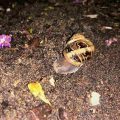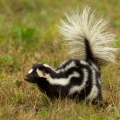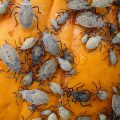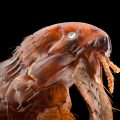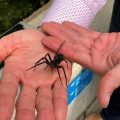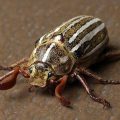Flying red ants can be a common sight during the summer months. These insects are often mistaken for termites, but they are actually a type of ant known as the Red Imported Fire Ant. While these ants are not dangerous in small numbers, a large infestation can cause problems for both humans and pets.
Flying red ants are usually about one-eighth to one-half inch long and have a reddish-brown color. They have two pairs of wings that are clear or slightly brown in color and are longer than their body. When they swarm, they can be seen flying in large groups, often near light sources.
Red imported fire ants are known for their aggressive behavior and painful stings. They are attracted to sweet foods and can often be found near trash cans, picnic areas, and other places where food is present. They can also build large mounds in lawns and gardens, which can be unsightly and cause damage to lawn equipment.
To prevent a red imported fire ant infestation, it is important to keep your home and yard clean and free of food debris. Trash cans should be sealed tightly, and pet food should be stored in airtight containers. If you have a lawn or garden, make sure to keep it well-maintained and remove any debris that could provide a home for the ants.
If you do find a red imported fire ant infestation, there are several options for treatment. One option is to use a bait that conains a slow-acting poison that the ants will carry back to their colony. This can be effective in reducing the population over time. Another option is to use a pesticide spray directly on the ants and their mound. This should only be done by a professional pest control company to ensure safety and effectiveness.
It is important to be aware of the presence of flying red ants and take steps to prevent and treat infestations. With proper prevention and treatment, you can keep your home and yard free of these aggressive and potentially dangerous insects.
Are Flying Red Ants Harmful?
Flying red ants, also known as fire ants, are known for their painful sting. They are considered harmful as their sting can cause severe allergic reactions in some people, leading to anaphylaxis. In rare cases, their sting can also be fatal. Fire ants are aggressive and swarm when their nest is disturbed, increasing the risk of multiple stings. The sting of a fire ant can cause a burning sensation, redness, and swelling. In addition, fire ants can also cause damage to agricultural crops and electrical equipment. It is important to take precautions and avoid contact with fire ants to prevent their sting and potential harm.

Why Do Flying Ants Appear Suddenly?
Flying ants appear suddenly because it is part of the annual reproductive cycle of ant colonies. The process starts with the development of winged male and female ants called alates. These ants then swarm out of their nests in large numbers in search of mates. The swarming usually occurs during warm and humid weather, typically in the summer months.
Once the male and female alates mate, the males die, and the females shed their wings and begin to establish new colonies. This process is crucial for the survival and expansion of ant colonies, but it can be a nuisance for homeowners when large numbers of winged ants suddenly appear in their homes.
It is important to note that flying ants are not a sign of an infestation, but rather a natural occurrence that happens every year. However, if you notice a sudden increase in the number of flying ants in your home, it may be a sign that there is a nearby ant colony that needs to be addressed.
What Attracts Flying Red Ants?
Flying red ants are attracted to sweet substances such as honey, sugar, and other sugary products. They are also attracted to protein-rich foods like meat, cheese, and other similar products. In addition, flying red ants are attracted to moisture, so they may be drawn to areas with high humidity or water leaks. It is important to keep your kitchen and pantry clean and free of crumbs or spills that might attract flying ants. Make sure all food items are tightly sealed and stored properly to prevent any ant infestations. Regular cleaning of your home, especially in high-moisture areas, can also help prevent the attraction of flying red ants.
How Do I Get Rid Of Flying Red Ants?
To get rid of flying red ants, you can use a mixture of liquid dish soap and water. Mix one part of liquid dish soap with two parts of water in a spray bottle. Add several drops of peppermint oil to the mixture and shake the bottle well. Then, spray the flying ants wherever you see them. The soap in the mixture will dehydrate the insects, while the peppermint oil will suffocate them.
Another effective way to get rid of flying red ants is to use insecticide sprays or baits. You can find these products at your local hardware or home improvement store. Make sure to follow the instructions on the label carefully when usng these products.
In addition, you can try using natural remedies such as diatomaceous earth, vinegar, or citrus oil. Diatomaceous earth is a powdery substance that is made from the fossilized remains of tiny aquatic organisms. It is safe to use around pets and children and can be sprinkled around the areas where you see the ants. Vinegar and citrus oil can be mixed with water and sprayed on the ants to repel them.
To prevent flying red ants from entering your home, make sure to keep your food and trash properly sealed. Also, seal any cracks or holes in your walls or foundation that may be providing entry points for the ants.
Conclusion
Flying red ants may be an annoyance but they are generally not dangerous to humans. However, they can cause property damage and lead to an infestation if left unchecked. It is important to keep sweet products tightly sealed and maintain a clean household to avoid attracting these insects. If you do find yourself with a swarm of flying ants, you can use a mixture of liquid dish soap, water, and peppermint oil to get rid of them. By taking these precautions and being proactive, you can successfully manage any potential issues with flying red ants.

